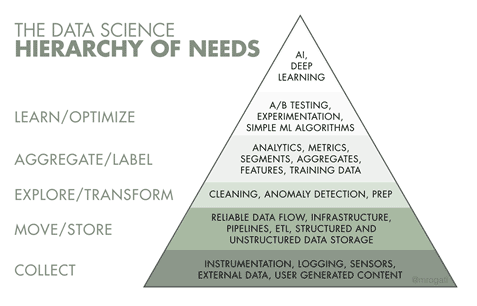How to create AI Strategy? The Definitive guide
In the era of fast-advancing technologies like connected devices and complex algorithms, AI is inspiring every industry. From furtive start-ups to techy companies to asset-intensive industries, teams are agitatedly working on their AI strategy. However, it comes down to one high-stakes, crucial question – How do we use Machine learning and Artificial Intelligence effectively?
In most cases, the companies are not successful in building AI solutions. Maybe due to inadequate knowledge on data literacy, or maybe their first data scientist lacked capabilities to deal with it. But the most common scenario, what our Machine Learning consultants say, is the zero-infrastructure readiness to implement data science operations & algorithms or Artificial Intelligence. In order to implement and reap the actual benefits of AI, companies must firstly need to meet the basic requirements like data literacy and data collection. Consider Maslow’s hierarchy of psychological needs as shown in the below image, illustrated by a data science advisor, Monica Rogati, to create an AI strategy. Think Artificial intelligence as the top level then all the other levels are the basic needs that have to be firstly met. That means, the algorithmic complexity of achieving the upper level needs increases dramatically.

Source: Hacker Noon
Here are the various step by step requirements that an organization need to fulfill to set-up a reliable data engineering system for successful Artificial Intelligence implementation.
Data Collection
The first preliminary need is to collect data. What & how data is being collected from sensors, devices, data logging systems, or machines? What data is available to analyze? After all, it is the right dataset that can help make advances in machine learning possible. So, right data collection setup needs to be in place to create a successful AI strategy. Data Flow – Move & Store
The second need would be to have a reliable and scalable pipeline architecture, seamless Extract, Transform and Load (ETL) process and a proper IT infrastructure. This is to answer questions like – where do you store the data and how does it flow through the system? How easy is it to access and does it handle both structured & unstructured data for analysis?Explore and Transform
But to sift through the vast ocean of data and gain insights, there is need for experts who can deal with any kind of data. That’s where data science and data scientists comes in. Data science encompasses the scientific methods, processes & systems that can generate required insights. It is an interdisciplinary field with concepts shared from statistics and data analytics. And, data scientists use scientific methods to clean the collected data, eliminates the anomaly and prepares the data for further processing.Aggregate and Label
At this stage, data scientists need to apply various data analytics techniques such as clustering, support vector machines, etc., in order to identify the patterns. The data can then be segmented & aggregated as a set of features that best represent the phenomena. They have to start preparing the training data needed to learn or predict by generating labels.Learn and Optimize
Here, at this level, an experimentation or A/B testing framework must be in place to incrementally deploy simple ML algorithms. This must go through continuous iterations until the results are satisfactory. This will also help to learn the features from the training data to classify and optimize the new data correctly.
All set for the Top level – Artificial Intelligence
Finally, after the fulfillment of all the needs, the stage is set for the development of Artificial Intelligence systems. This would be the last phase to create a successful AI strategy. Now that the data is organized and cleaned; you have sounding ETL, labels and dashboards, to measure the right things effectively with a running baseline Machine Learning algorithm, you are all set to deploy Artificial Intelligence solutions, which use complex deep learning algorithms for delivering impressive results.
For illustration, one of our leading water utility client wanted a Smart analytics system to deal with supply-demand challenges and conserve water. Our teams started with water consumption & billing data and leveraged plethora of Azure services to build the system. Machine-learning intelligence was achieved with ETL process, data cleaning & flow, instrumentation, data segmentation & metrics, data stories, etc., in place. Now, Water utilities are utilizing the systems and are able to save billion gallons of water daily.